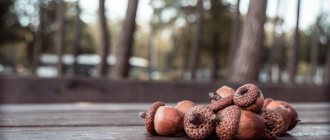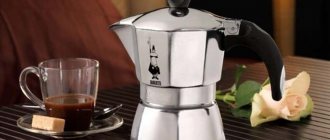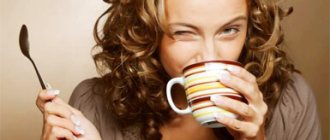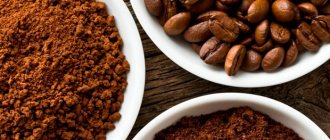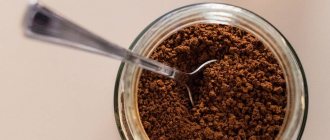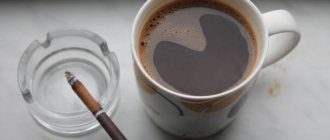Coffee is an invigorating drink, without which many people cannot imagine their daily life. Today, coffee lovers brew the drink in modern devices that make the preparation process easier.
But not everyone manages to create truly tasty and velvety coffee. That is why it is necessary to figure out how to properly brew a drink at home, and what methods are relevant now.
Brewing coffee
Benefits of coffee beans
Coffee beans have the following advantages:
- suitable for storage;
- contains a lot of caffeine;
- has a pronounced aroma and taste;
- suitable for preparation in a coffee machine;
- You can choose the degree of grinding yourself;
- suitable for blending.
The last point is the most interesting. Coffee gourmets can pamper themselves with mixtures of beans of different degrees of roasting or countries of origin and enjoy new shades of taste every morning.
Declension by case
In Russian, this word is borrowed and refers to nouns denoting various substances (sugar, cream, blood, etc.), so it cannot be unambiguously classified as either singular or plural.
The word "coffee" is inflected the same way, regardless of meaning, case or number.
Usage examples:
- guests treated to (what?) coffee - TV. P.;
- wash the cup after (what?) coffee - R. p.;
- please make (what?) coffee - V. p.
Dictionaries indicate that this word will be declined in the same way, regardless of meaning, case and number.
Historical reference
We have borrowed a very large number of words from foreign languages. Many of them have been changed. As noted above, almost all words, such as atelier or meringue, ending in the vowel “e”, began to be classified as neuter. But the word “coffee” remains outside these rules.
For unknown reasons, the gender of coffee has been preserved as in the native English language. Previously, the pronunciation was different - coffee or coffee. And this is definitely masculine.
This state of affairs leads to constant disputes and confusion. Most teachers of the Russian language defend the opinion that the word is masculine and has no declensions. But recent changes and reforms have called this position into question.
Coffee with cinnamon in a saucepan
Cinnamon is a universal seasoning that can tone up and reduce appetite. In addition, it is ideal in combination with coffee. To prepare this drink you need:
- 1 tsp. - coffee;
- 100 ml – cold water;
- 1/3 tsp. – granulated sugar;
- 1/3 tsp. – cinnamon.
Preparing this recipe is not difficult. Mix all ingredients except water and place at the bottom of the pan. Heat slightly over low heat and add water in a thin stream. Cook until a foamy layer appears. After that, you need to remove the pan from the heat and pour a little into a portion cup, then put it back on the fire. Do this several times. The resulting coffee is ready, you can start drinking.
French press
Perhaps this is the simplest and most convenient device that is suitable even for beginners. It can also be used in an office where there is no coffee machine or stove. To prepare the drink you need to take 3.5 tbsp. l. coarsely ground coffee and pour 0.5 liters of boiling water over it.
After 3-4 minutes, foam forms on the surface. After this, the coffee needs to be stirred, covered with a plunger and left to brew for 5-6 minutes. Then gently lower the plunger and pour the finished drink into a cup.
Coffee cools quickly in a French press, so make only as much coffee as you can drink at one time. In addition, the brewing process continues after you lower the plunger. Do not overcook the drink in the French press to avoid excessive bitterness.
If you want to make green coffee, a French press is the best option. This variety cannot be boiled, as it loses its main valuable qualities. In addition, green beans are ground coarser due to their greater hardness. The French press creates the optimal temperature for obtaining a healing drink.
What is the healthiest way to brew coffee?
Regarding the first factor, experts recommend a French press or pour over (a method of brewing coffee in which hot water is passed through ground coffee in a special funnel with a paper filter), since brewing occurs in a container made entirely of glass or stainless steel.
French press and pour over are also preferable from the point of view of the second factor: “The stainless steel mesh filter on the French press and the open pour over method help to release the essential oils of coffee, which not only improves its aroma, but also preserves polyphenols that have anti-cancer properties.” " explains Dave Asprey, who revolutionized the world of coffee with his invention of the bulletpfoof latte ("armor-piercing coffee" with added fat).
Other methods of brewing coffee have other disadvantages. "Your favorite capsule and single-serve coffee machines are less preferred due to the packaging of the capsules and the danger of mold growing in the machine itself if you don't clean it regularly and thoroughly," says Cole.
Diterpenes contained in oils help raise both LDL cholesterol and cholesterol in general, but studies have also shown that diterpenes are associated with many of the beneficial properties of coffee, including its ability to fight cancer.
Both capsule and standard drip coffee makers contain filters
,
which reduce the level of diterpenes in the resulting drink
. Instant coffee contains almost no diterpenes as they are filtered out during the processing process.
Coffee machine
This is perhaps the most complex of household appliances for brewing coffee at home. Steam pressure forces water through a layer of ground coffee and brews it at a high temperature. The taste of the drink is strong and rich. These coffee machines have an automatic or manual cappuccino maker.
The water container usually has a volume of 1 to 1.8 liters, and the milk tank has a capacity of up to 0.4 liters. You can prepare a couple of cups of aromatic espresso, double latte or cappuccino with thick milk foam.
However, despite the almost complete automation of the process, the coffee machine requires certain skills and dexterity. She is quite critical of the freshness of coffee beans and the degree of grinding. Ideally, no more than a month should pass after roasting.
Not only the taste, but also the character of the strait depends on the freshness of the grains. You will also have to learn how to properly dose, distribute and compact coffee powder in a cone.
If the streams of liquid quickly turn pale, and the taste of the finished drink seems watery and sour, use a finer grind. If streams appear late and the coffee tastes bitter, coarse the grind.
The wide range of models of modern coffee machines excludes the formulation of any universal recipe for making coffee. You will have to adapt to each specific model by trial and error. But, following the manufacturer’s recommendations and relying on your own taste sensations, you will find the best option for the drink.
If you don’t already have such an appliance in your kitchen, read our article about choosing a coffee machine.
What is filter coffee and how is it different from a funnel? And from Americano?
The filter is a simple installation: there is a small ladle where you place a paper filter, similar to a muffin pan. By adding 120 grams of freshly ground coffee and running water, you can get two liters of coffee and store it in a thermos. The main advantage of this brewing method is the speed of delivery. You can get a drink in a minute and go about your business. This is the standardization of coffee preparation - the result will always be a solid eight out of ten.
The funnel got its name because of its shape: it looks like a coffee cup, tapering towards the bottom. Coffee in a funnel (this brewing method is called pour-over), unlike filter coffee, is prepared entirely by hand. Glass, ceramic or iron are placed on a special glass coffee pot or on a mug. Next, place a paper filter in it, pour in freshly ground coffee and fill it with hot water. The cooking process takes longer, but the taste may be better. Or, conversely, worse - the human factor plays a big role, so such a drink is easy to spoil.
Americano is an espresso-based drink, not a brewing method. When an American says “coffee,” he means filter; an Italian means espresso. During World War II, Americans in Italy received thick coffee extract instead of a huge mug of coffee and did not understand what it was. Then the Italians began to add water to espresso and called it “Americano”. A dense and tart drink is easy to distinguish from a filter: the second is more watery and easier to drink.
Turka, or cezve
This is my favorite way. It seems to me that coffee prepared in a traditional Turkish coffee pot on the stove turns out to be the most delicious. This is a special ritual, and if you act step by step, taking into account all the subtleties, the result will exceed expectations. Of particular importance for this method are:
- Turk, its shape and material;
- degree of grinding of coffee beans;
- at what heat and for how long is the drink brewed?
I’m ready to share a simple step-by-step recipe that I use myself.
The material of this vessel can be different - stainless steel, ceramics, clay, copper. The latter is preferable. The copper pot heats up evenly and is insensitive to sudden temperature changes. It can be washed immediately after use.
The inner surface must be coated with food-grade tin or silver. Its safety must be carefully monitored to avoid chips and scratches. Copper, when heated, releases harmful compounds that should not enter the body.
The bottom is preferably wide and thick, and the neck is narrow. The optimal volume is 1-2 cups. Before you start cooking, it is recommended to warm up the turk or cezve so that the aroma and taste of the coffee are revealed more fully.
Pour finely ground coffee into the Turk at the rate of 2 tsp. with a slide of 150 ml of water. Often large manufacturers give their own dosage recommendations, which are written on the packaging. If you love spices, now is the time to add them, as well as sugar. Now you need to wait a few minutes for the mixture to warm up and release its aroma.
Since the copper Turk cools down quite quickly, bring it periodically to the fire for a few seconds. Be careful not to let the coffee powder and sugar start to burn. Otherwise, instead of a fragrant drink with a caramel tint, you will end up with a bitter liquid with a burnt sugar taste.
Professional baristas and experienced amateurs insist that the water must be poured cold. The drink should be warmed up gradually so that the taste and aroma are rich and the beneficial substances are better preserved. To be honest, I don't always do this. If there is not enough time for a “ritual according to the rules,” I fill it with hot water. At this stage, the drink can be stirred only once.
Strictly speaking, you cannot brew coffee. It needs to be heated without boiling. It is no coincidence that Turkish coffee is prepared on hot sand. In this way, the optimal temperature is obtained - the drink does not boil, but manages to achieve the desired consistency and readiness.
In principle, this process can be organized at home. You need to take a large frying pan with high sides, preferably cast iron. Pet stores sell purified fine sand for aquariums - it is perfect for a home “oriental coffee shop”.
Pour it into a frying pan and heat it evenly over low heat. We immerse the Turk in it and smoothly move it in a circular motion, observing the formation of foam. As soon as it begins to rise, we remove the Turk from the sand. Let it settle and warm it up again in the sand.
Repeat the “boiling” cycle three times. Then let the finished drink sit for a couple of minutes. During this time, the coffee grounds will settle to the bottom and the coffee can be poured into cups. If you don't want to wait, just add 2 tsp to the Turk. cold water. The result will be the same - a drink without grounds.
Of course, you don’t always have time to make coffee at home this way. In everyday life we use a regular stove. But the principle is the same - let the foam rise three times over low heat and do not boil.
Some coffee lovers recommend pouring boiling water over their coffee cups before pouring the drink into them. This way it will retain heat longer. Others recommend drinking it with cold water to cleanse your taste buds and enjoy the drink to the fullest. And at the same time, wash off the coffee pigment before it has time to be absorbed into the tooth enamel.
You can add milk to the finished drink to soften the effect of caffeine. Or you can add a slice of lemon to enhance the invigorating effect. Just do not forget about a sense of proportion - no more than 4 cups a day, so as not to harm your health.
What kind of coffee can you make at home?
All methods of making coffee are divided into two camps: classic and alternative.
Classic methods are all coffees that are based on espresso: cappuccino, latte, flat white, and so on.
Alternative methods include all other coffee: from the usual Turkish coffee and geyser coffee maker to the now fashionable Chemex, AeroPress and V60. Brewing ground coffee in a glass is also an alternative preparation method.
Alternative methods include coffee in capsules, but I will talk about them separately.
The Right Ingredients
Arabica has a more noble taste with a slight sourness, Robusta is coarser, astringent and strong. Robusta is never used in its pure form, only as an admixture to Arabica. It produces excellent dense crema in espresso, which is why baristas love it.
The taste of coffee depends on many factors: place of growth, degree of roasting, combination of varieties (if it is a mixture), storage conditions.
Proper coffee is sold in opaque packaging with a degassing valve, which removes carbon dioxide outside and prevents oxygen from penetrating inside. After roasting, coffee releases several liters of carbon dioxide during the day. If you see a package in a store without such a valve, it means that the coffee was not packaged immediately after roasting, but was left to degas for some time and has significantly lost its taste. Essential oils partially evaporate during degassing.
Look at the roast date. The closer it is to today's date, the better. Ideally, no later than two weeks, but this is difficult to achieve even for stores specializing in selling only coffee and tea.
Take coffee beans. There are several reasons for this.
- Self-ground coffee eliminates the presence of foreign impurities in the cup. It is easier for unscrupulous producers to mix cheaper varieties of robusta and even chicory, malt, barley, and rye into ground coffee. It’s better to grind it yourself, even in the simplest coffee grinder.
- The basis of the taste of coffee is essential oils. As we now know, oxygen is the main enemy of proper taste. Grinding before immediate brewing will maximize the aroma of the beans.
- You have more opportunities to experiment. Coffee for espresso machines requires a medium grind, for a French press - coarse, and for Turkish coffee it should resemble flour.
- You will be able to evaluate the shape of the grain itself, make sure that the grains are the same size, matte and intact. The uniformity of the grains eliminates the admixture of cheaper robusta. The shine indicates that the grain has been stale and has already begun to release essential oils. The splinters will produce a bitter taste as they are roasted more intensely than the whole grain. Of course, you can understand all this only when you open the package and draw conclusions about the manufacturer for the future.
Ideally, spring water, but you can get by with filtered water. The main thing is not to take water directly from the tap and do not use already boiled water.
Some coffee lovers add a little salt when preparing, which helps to better reveal the taste and aroma of coffee and reduce bitterness. If you decide to use salt, then use the most common table salt, coarsely ground. There is a risk of over-salting with the extra variety, and iodized salt will give an unpleasant aftertaste.
From theory we move on to practice - brewing coffee.
No more than four cups
There are coffee lovers who drink coffee both at home and at work, and sometimes several more cups in a row. This is especially true for those who engage in intense mental or physical labor. Let's say, programmers or drivers.
Experts say: the maximum that a healthy person can afford is four cups of coffee a day.
And small ones at that. The kind they usually serve in cafes.
If you are used to abusing coffee, then you have
- blood pressure may increase
- You may have trouble sleeping
- and dehydration.
Moreover, you may not even realize what is causing your poor health.
Which brewing method should you choose?
To choose your alternative method, I recommend trying each of them several times with beans from different parts of the world in different coffee shops. In my opinion, this will help you understand what kind of coffee you personally like.
Here is a list of the most famous and popular brewing methods with my subjective description:
- Turka - strong, aromatic, more often caramel-nut than berry-fruit.
- A geyser coffee maker is close to a Turkish coffee maker, but a little softer.
- V60, or pour-over - soft, berry-fruity.
- Chemex is brighter and denser than pour over, but overall very similar.
- The immersion funnel is even brighter and denser than the Chemex.
- Aeropress is very bright, strong and dense.
- Filter coffee - without any extremes, soft and good.
I brew a Chemex or AeroPress at home - these are two of my favorite ways to make coffee.
A Chemex is an hourglass-shaped container. A paper filter is placed on top, coffee is poured into it and hot water is gradually poured in. It passes through the coffee, brews and flows into the lower part of the vessel.
AeroPress is a kind of syringe. Coffee is placed inside and water is poured in, then the piston is squeezed and water under pressure passes through the coffee and filter into the cup.
I use 18 grams of coffee per cup of AeroPress or Chemex. If we assume that a pack of 250 grams of coffee cost 500-1000 RUR, then one cup of coffee costs me 30-60 RUR. In Moscow coffee shops, an Aeropress costs from 150 to 250 RUR.
What you will need
To ensure that the result does not disappoint you, you must take something into account.
- Water. It must be clean - ideally artesian, spring or well non-rigid. If there is none, at least bottled or filtered. From the tap it is not suitable, since impurities noticeably distort the taste of the finished drink.
- Coffee beans or ground. The answer to the question of how to choose coffee for home brewing depends on the result you want to get. For espresso, it is better to try a mixture of Arabica and Robusta. Any finely ground Arabica is suitable for Turkish coffee. And the taste options are completely limitless - from light sourness to floral notes. To get the best one, experiment with the roast level.
- Sugar, salt and spices. Personally, I don't like unsweetened coffee, so I add cane sugar. It is less harmful than refined white and does not spoil the taste of the drink. Salt on the tip of a knife will neutralize the bitterness if you find it too pronounced. At the same time, the taste of the salt itself is not felt in the finished drink.
I always make coffee with ground cinnamon and cardamom. They give the drink warm spicy notes and a light citrus aroma. Some people like to season their coffee with black pepper – it turns out to be a spicy, warming option for winter. Fresh or ground ginger is also a very popular addition and enhances the taste well.
- Milk or cream. Many people prefer to soften the taste of strong coffee and drink it with milk. The result is a nutritious drink that also neutralizes the effects of caffeine.
Now that everything you need is prepared, let's look at popular household appliances that will help you brew coffee correctly.
